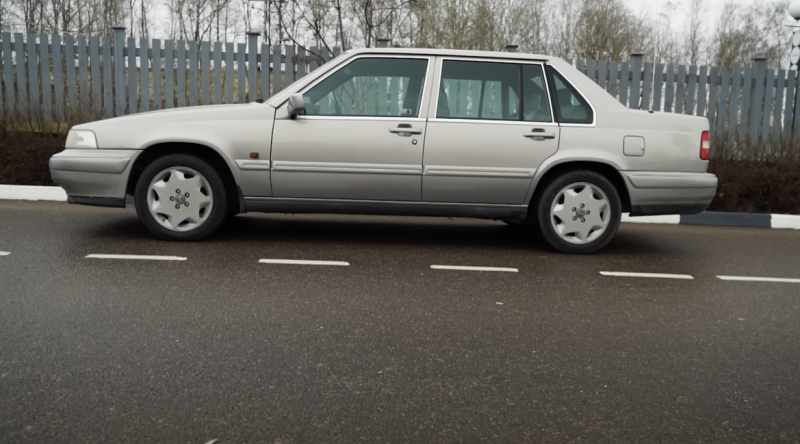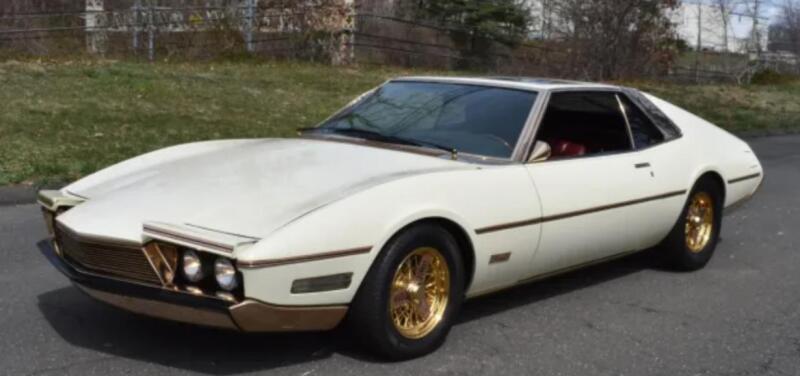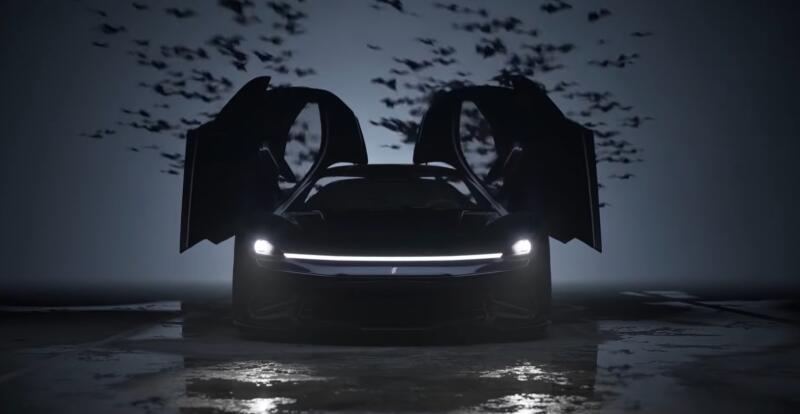The Motorama 1955 exhibition was no exception. The silk canopy on the podium for the time being hid a magnificent thing - the Chevrolet Biscayne. Here the thinnest canvas, thrown away by a deliberately careless hand, flew off. The smoke cleared, and reporters had the opportunity to capture the general "aah" of the amazed audience.
The model, caressed by greedy eyes, subsequently experienced incredible adventures: being sent into the jaws of a crushing machine, oblivion, wandering in a car dump. However, what is American history without a happy ending?
Chevrolet Biscayne concept
The creation of concept cars - prototypes of future cars - is credited to GM chief stylist Harley Earl. A great artist, a great master of auto design, came up with the idea of testing the audience’s reaction to a particular manufacturer’s decision.
 Chevrolet Biscayne concept car, created to demonstrate GM design solutions. Photo: YouTube.com
Chevrolet Biscayne concept car, created to demonstrate GM design solutions. Photo: YouTube.comConcept-cars are created to prepare the public for radical changes in the brand's stylistic direction, styling or technology. This time it was mainly about the exterior.
Technically, Chevy did not offer anything new. Therefore, the car stood on a hill, albeit with a motor, gearbox, suspension, brakes, but without a battery. The parprise was bashfully huddled with dummies of buttons and instruments.
How Chevrolet Biscayne appeared before the audience
The stunned people present had no idea about the unconnected electrics, just as they had no idea about the plans to destroy the concept. Visitors saw a stunning car. A stunning specimen. Something unusual. For example, there was no sign of the times on the stern - fins.
 The rear of the Chevrolet Biscayne is without the usual fins. Photo: YouTube.com
The rear of the Chevrolet Biscayne is without the usual fins. Photo: YouTube.comAmericans have not yet become tired of this decorative element, sometimes of gigantic proportions. But the people accepted the rear part without “shark tails” and other “bats” favorably. The look, by the way, was shaped by the talented stylist Chuck Jordan under the guidance of Harley Earl.
The developers designed the front optics of the 4-door sedan in an unusual way: the side lights were hidden in triangular holes on the wings. The headlights were built directly into the hood. The radiator grille was made up of 9 large chrome-plated “teeth”. Shiny metal, however, contrary to fashion, was used little.
At the stern there were double round lights and a thin bumper: it seemed that it was not going to fulfill its purpose. And the shape of the trunk lid anticipated the “duck tail” that was later found on the 1961-1962 Corvette.
We continue our tour of Biscayne.
The Stratospheric windshield extended upward and curved far back. The A-pillars were thin metal, which in combination with the panoramic roof gave excellent all-round visibility. The silhouette is low, the sides are beautifully drawn in: the car looked lean.
 Chevrolet Biscayne's doors open in different directions, but there is no center pillar. Photo: YouTube.com
Chevrolet Biscayne's doors open in different directions, but there is no center pillar. Photo: YouTube.comThe doors swung open in different directions. The option is not new, it is called sucide doors - rear-hinged doors for gallery passengers. What was strange was the lack of a center pillar. That is, the crew had nothing to hold on to during landing. The designers compensated for the inconvenience with an original solution: the front seats turned towards the person sitting down.
The shade of green paintwork on the exterior panels was unique. The stylists designed the interior to match the tone and color of the body. The wheels under the graceful arches seemed complex and intricate: a real work of art.
 Chevrolet Biscayne wheels: stylists spared no effort in creating such beauty. Photo: YouTube.com
Chevrolet Biscayne wheels: stylists spared no effort in creating such beauty. Photo: YouTube.comA high tunnel ran through the central part of the cabin, in which an ashtray and a cigarette lighter were provided for the rear passengers. The standard radio entertained fellow travelers on the road.
The fate of the model
The manufacturer, satisfied with the deafening popular reception, intended to destroy the sedan. Common practice: concept cars remain in the archives of the company on Whatman paper, sometimes in local museums or warehouses. But more often the cars are destroyed. The last scenario awaited our hero, the Chevrolet Biscayne.
 “Teeths” of the Chevrolet Biscayne radiator grille. Photo: YouTube.com
“Teeths” of the Chevrolet Biscayne radiator grille. Photo: YouTube.comIt was around Christmas. The employee responsible for disposing of the exhibition model was in a hurry to go home. He brought the car to a junkyard, where he was supposed to remain until the moment when the press turned the handsome man into a chubby man. But, without waiting for the painful procedure, he left the territory.
Oblivion at the junkyard
The place where the GM worker fled to the Christmas turkey was a posh dumpster. The junkyard in the industrial area of Detroit was called Warhoops auto. Geographical location – it couldn’t be better. The Big Three factories were based nearby: Ford, Chrysler and General Motors.
 The Biscayne's headlights are built into the hood. Photo: YouTube.com
The Biscayne's headlights are built into the hood. Photo: YouTube.comManufacturers brought junk cars here and stored them along the high school fence, including concepts that were to be destroyed. Here, in the zone of unceremonious burial of unique people, the ghosts of great cars roam. The muddy ground is strewn with fragments of the magnificent designs of yesteryear. Here our martyr Chevrolet Biscayne languished in oblivion.
Wonderful salvation
Luxurious in a certain sense, Warhoops auto was a place of pilgrimage for antique lovers. Those who are not indifferent to the automotive heritage of humanity.
 The Chevrolet Biscayne interior is made in body colors. Photo: YouTube.com
The Chevrolet Biscayne interior is made in body colors. Photo: YouTube.comCollectors often come here in search of masterpieces. It happens, not without success, that rarities are found, the automotive fantasies of designers embodied in metal.
A similar thing happened in 1988: Michael Bortz, the son of the famous collector of lost concepts Joe Bortz, wandered into the landfill. In the rusted front hood without headlights and with the tarnished “teeth” of the radiator grille, the young man recognized the Biscayne.
 This Biscayne steering wheel is worth a look. Photo: YouTube.com
This Biscayne steering wheel is worth a look. Photo: YouTube.comOver the next year, Michael dug through piles of scrap metal, looking for the missing pieces of the car. I found fenders, a trunk, a roof—a total of 8 body parts. The meager parts were loaded onto a van and taken to Highland Park, Illinois, to be recreated. Thus ended the years of Chevrolet Biscayne's ordeal in a junkyard.
Rebirth of past glory
The half-rotten frame was restored in the workshops of Bortz Sr. There was no chassis or engine. As the restorers said, the owner of the landfill gave the “cart” and technical stuffing to that same school behind a high white fence. Apparently, to study the design of vehicles. The case threatened to remain unfinished.
 Chevrolet Biscayne delights audiences at fairs. Photo: YouTube.com
Chevrolet Biscayne delights audiences at fairs. Photo: YouTube.comGM management heard rumors about the specialists' difficulties. Drawings and a precise description of the concept were extracted from the factory archives. With the documentation, the work went faster: the car was recreated in full splendor.
To celebrate its 100th anniversary in 2008, General Motors Corporation organized an enchanting auto exhibition. The Chevrolet Biscayne, dazzlingly shining, was the star of the show.
Technical characteristics of the 1955 concept
Subsequently, the car was shown more than once at public events. She traveled to concours of elegance on her own, having under the hood an engine with the following characteristics:
✅ Volume - 4344 cm3
✅ Power - 215 liters. With.
✅ Number of cylinders – 8 with V8 architecture
The engine is located longitudinally at the front. Power system – 4 chamber carburetor. Torque is supplied to the rear axle through a 2-speed Powerglide automatic transmission.
Road obstacles are repelled by the front independent suspension on springs. Rear dependent design on springs. The braking system uses hydraulic drum mechanisms.
 Chevrolet Biscayne at the Peterson Automotive Museum, Los Angeles. Photo: YouTube.com
Chevrolet Biscayne at the Peterson Automotive Museum, Los Angeles. Photo: YouTube.comThe Bortz family donated the car to the Peterson Automotive Museum in Los Angeles. The entrepreneur’s car collection still includes more than 2 dozen outstanding exhibits found in landfills. But the treasure hunt continues. So, we are waiting for new “trophies”.










